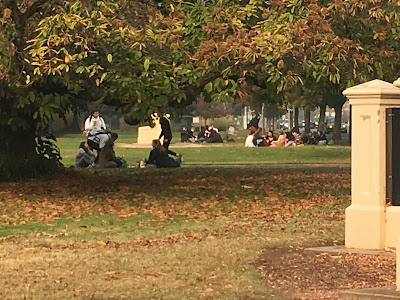The usual number of High School Students eating lunch outdoors when county guidelines dictate keeping them indoors for the then Air Quality Index of 172.
A lot of parents in Sonoma County, California are frustrated by the lack of guidance or what may seem like poor guidance from our county and district school leadership with regard to the current air quality crisis, but it’s important to understand what level various decisions are made at and communicate concerns where they will be effective. This kind of crisis is not covered in any of the school safety plans I’ve seen. Creating a detailed site specific safety protocol on the fly is difficult. It’s usually created by the site administrators and modified and approved by the School Site Council or Principal Advisory Board for the following year. (School Site Councils are usually in need of parent members and you can always show up and bring attention to issues that are important to you.) Certain protocols are set higher up at the district and county level by administrators, not usually School Boards, though they may be modified and adopted by the School Board. These tend to be more general, like the maximum cutoff for all schools to close, leaving room for individual sites to manage their own details.
Last Friday schools across Sonoma County closed for their first bad air day. No official guidlelines for doing this existed so they were promptly written this week. It’s not surprising for a policy created on the fly to leave a lot of people angry, nor for it to be implemented poorly at first. I sent the Superintendent of our Office of Education a few pictures today, including the one above, of how their guidelines were being interpreted at the site level at a high school. He responded immediately with shock and looped in the Superintendent of our school district, the next person who they expect to narrow down the policy and create more specific guidelines. The Office of Education created a cutoff for keeping students indoors and closure guidelines, but no guidelines for how to protect indoor air quality in classrooms or where to have kids eat lunch when there is no indoor lunch area on a campus, or how to minimize exposure when every time you change classrooms you have to walk long distances outside. These specifics are a lot more work to nail down and differ between individual schools based on their buildings and needs. When these policies and procedures are created they need to be communicated all the way down to the janitors and part time yard duty or they won’t be effective. Air is hard to exclude.
Principals are trying to mediate between the limited guidance they’re getting from the district, a school site level crises, and the fear and anger of parents, leaving them very little time to inspect their campuses to be sure that indoor air quality is being managed properly, or research how to properly manage indoor air quality since this isn’t their field, and alter school schedules and plans to keep kids inside because their usual protocols are designed for rain, not bad air. Bring attention to things that concern you by all means, but don’t attack our Principals. You wouldn’t want their job right now.
When you want to express a disagreement or problem with a policy remember, what you post on social media will not make anything happen, but anything they receive by email they must respond to. Photos are excellent because they are more objective than verbal arguments. Parents have more influence on school policy than teachers because we’re effectively the customer and the administration is not hearing from us every day. Be the nice customer they want to help. Learning to be an effective advocate and taking time to understand how the system we want to influence is set up will help us avoid undue frustration and accidentally harassing the people who are working hard to help us. Take the time to look up the right administrator’s email.
